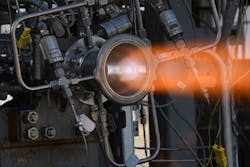NASA develops additive manufacturing method for rocket engine nozzle technology
Knowing that rocket engine nozzles are complex and expensive to manufacture, a team of engineers at NASA's Marshall Space Flight Center (Huntsville, AL) developed an additive manufacturing technique for nozzle fabrication that can greatly reduce costs and development time. The technique, called laser wire direct closeout (LWDC), uses a freeform-directed energy wire deposition process to fabricate material in place—it has the potential to reduce build time from several months to several weeks.
Related: NASA tests 3D-printed rocket engine parts
Nozzles may look simple from the outside, but they are very complex. The LWDC method employs a wire-based additive manufacturing process to precisely close out the nozzle coolant channels, which contain the high-pressure coolant fluid that protects the walls from the high temperatures a nozzle must withstand.
Nozzles are actively cooled, or regeneratively cooled, meaning the propellant later used in the combustion cycle is routed through the nozzle to properly cool the walls so they do not overheat. To regeneratively cool the nozzles, a series of channels are fabricated within the nozzle, but then must be closed out, or sealed, to contain the high-pressure coolant. The new process using the LWDC technology closes out the coolant channels and forms a support jacket in place, reacting structural loads during engine operation.
"Our motivation behind this technology was to develop a robust process that eliminates several steps in the traditional manufacturing process," says Paul Gradl, a senior propulsion engineer in Marshall's Engine Components Development & Technology Branch. "The manufacturing process is further complicated by the fact that the hot wall of the nozzle is only the thickness of a few sheets of paper, and must withstand high temperatures and strains during operation."
After Marshall co-developed and patented the LWDC process, Keystone Synergistic (Port St. Lucie, FL) used the technology to fabricate and test a nozzle. Through hot-fire testing at Marshall, engineers put this nozzle through its paces, accumulating more than 1040 seconds at high combustion-chamber pressures and temperatures. Now, this technology is being licensed and considered in commercial applications across the industry.
The second technology tested as part of this campaign was an abrasive water jet milling process to form the coolant channels advanced by Ormond, LLC (Auburn, WA), while a further technology developed was an arc-based deposition technology to additively manufacture the near net shape liner that would contain the water-jet milled channels.
All three technologies were developed through NASA's Small Business Innovation Research (SBIR) program, working to bring together the agency with its industry partners to advance manufacturing.
For more information, please visit www.nasa.gov.
